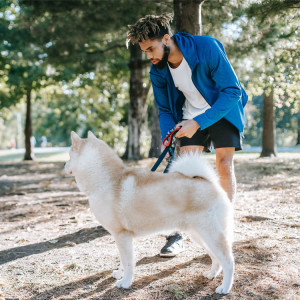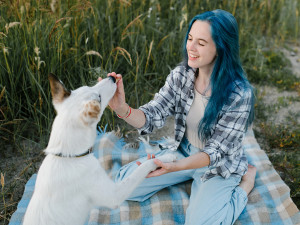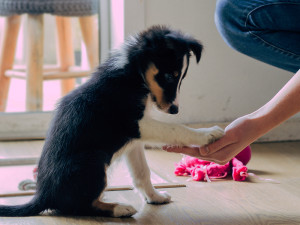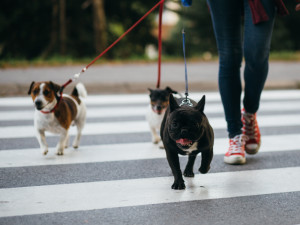How To Stop a Dog From Pulling on the Lead
Tug of war every time you head for a walk is not the one
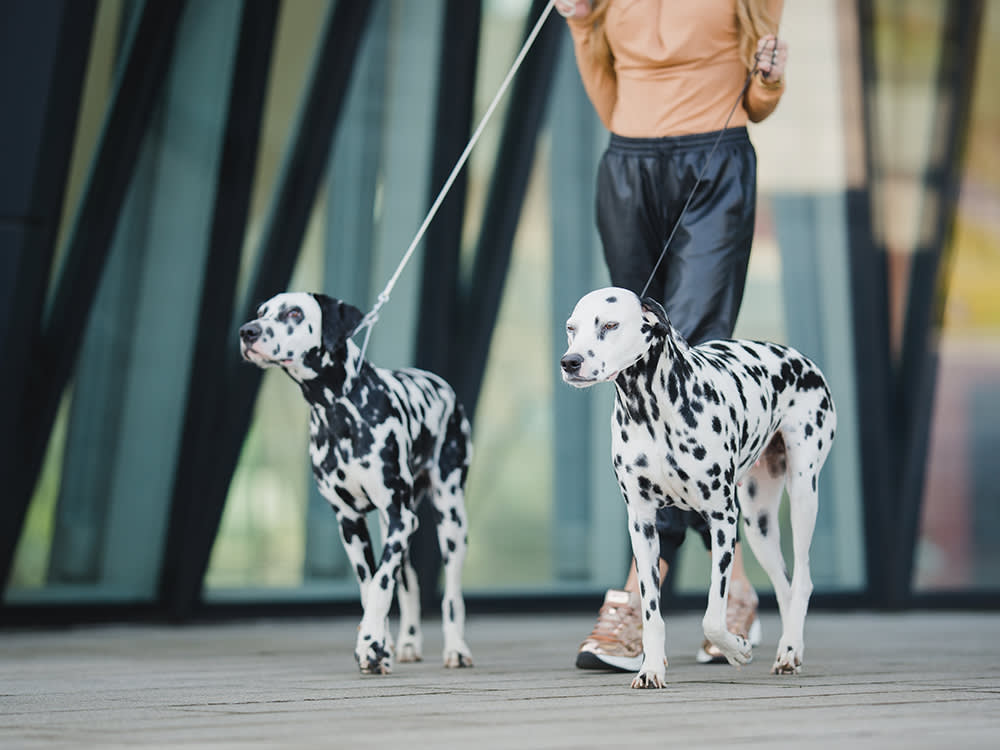
Share Article
In this article:
How to stop a dog pulling lead Training for lead pulling When should I seek help? Why dogs pull lead Consistency and lead training Loose-lead walking Lead training challenges FAQs on lead pulling
Ever find yourself being walked, rather than the other way around? If your dog pulls on the lead, it can make walks stressful and impact your bonding time. While quick-fix solutions may not have worked, with some simple techniques and a whole lot of patience (and treats!) you can get your on-lead walks back on track. Phew!
How to stop a dog from pulling on the lead
Although working on loose-lead training doesn’t sound as fun as having off-lead adventures with your dog or teaching them fun tricks, lead training doesn’t have to be boring – with a positive approach and a little creativity, you can enjoy teaching your dog these new skills.
You might be struggling with overexcitment in your dog, they may want to say hello to every dog/human that they see. Perhaps they’re anxious and tend to freeze on walks? Or maybe you’re wondering how you can stop your dog biting the lead? And if we’re honest, we can sometimes be guilty of contributing to the lead-pulling challenge just as much as our dogs. Remember that lead has two ends – and you’re holding one of them!
1. Use the right walking equipment
Just as you’d wear protective gear on a building site or waterproofs for a rainy dog walk, it’s as important to consider if the equipment we put on our dogs is benefiting them – or us.
A well-fitting Y-shaped harness distributes pressure more evenly than a collar, making it the kinder option despite research showing that dogs may pull harder on harnessesopens in new tab. A double-ended lead can provide added better control.
2. Use your movement to your advantage
Playing with movement can be a great way of creating more interest for your dog. Think about how your dog moves its body when it has the choice, off-lead… do they walk in a dead straight line? No! Dogs naturally weave and explore off-lead, so mimic this by changing direction or looping backwards. Reward them with yummy treats every time they match your turn.
3. Exercise your dog before you walk
Letting your dog release energy through sniffing or play before your walk, can help them focus better during the training parts of your walk. Allowing them some time to just ‘be’ in the outside world first, to let them catch up on the latest pee-mail sniffs, before you try to get them working for you can also help.
4. Train your dog to have good lead manners
Unfortunately, our dogs don’t come with an instruction manual that tells you the simple way to get the behaviour you desire – especially when it comes to lead walking.
A good starting point is to reward your dog any time there’s no tension in the lead. Mark the moment with a “yes” or a clicker, then give them a small piece of yummy food. Small, soft, and stinky treats are not only going to offer the best motivation, but will allow you to reward your dog many times throughout a walk.
5. Set your dog up for success
Train at the right time for your dog and, most importantly, in the right situations. Taking your dog into the middle of a dog field, with lots of potential friends (or foes) around, and trying to get them to listen to you is setting them up for failure. So is trying to achieve perfect heelwork when they’re feeling anxious or over-tired.
Short, fun training sessions work better than trying to train for an entire walk.
6. Use a longer lead
Studies show dogs are more relaxed on longer leadsopens in new tab. A 2-3 metre lead may reduce pulling compared to a shorter one. But please avoid flexi-leads as they can actually reinforce pulling.
7. Be consistent
Whenever we want to teach our dogs new skills, consistency is always going to be important. That’s both in consistently showing up for training sessions with your dog (not letting the learning fall by the wayside after two or three days) and also in the way you are teaching your dog.
Use the same cues, rewards, and techniques across all training sessions. Ensure family members follow the same approach.
8. Use rewards
Reinforcing the behaviours you want your dog to repeat in the future is key to solidifying learning. Motivate your dog with tasty treats, playtime, or verbal praise whenever they’re walking calmly with you. Without reinforcement, your dog might seek their own rewards, like sniffing or pulling toward distractions.
Training techniques to get a dog to stop pulling the lead
Using a positive, fun approach to training your dog will help them to feel motivated to engage in the learning process. Use things that motivate your dog based on their breed or individual desires.
1. Positive reinforcement training
Science-backed positive reinforcement training is the most effective and ethical way to work with your dog. Rewarding desired behaviour is more effective than punishing lead-pulling. Avoid aversive methods, such as jerking the lead or using a prong collar, as they can harm your dog both physically and emotionally.
2. Teach the heel command
Using specific words to ask our dogs to do something – in this case, walking without tension in the lead – can provide clarity. Use a cue like “heel” to differentiate between relaxed walking and the more structured training parts of your walk.
3. Stop-and-go technique
A commonly used technique to avoid pulling on the lead, is to restrict your dog’s movement forward whenever there is tension in the lead - like a traffic-light system. Stop moving when your dog pulls (red light). Move forward when the lead is loose (green light).
While this can be very effective, especially with younger dogs in low distracting environments – for some dogs the ‘stopping’ part may cause them some frustration or even feel punishing.
4. Change directions
As we discussed earlier, adding movement into your walks through changes of direction can provide more interest for your dogs during on-lead walks. It can also bring their focus and attention to you and where your body is moving next.
Changing direction also allows us to create space between ourselves and a distraction – such as another dog or some traffic.
When to call a behaviour specialist for lead pulling
As with any form of challenging behaviour, it can be useful to have the guidance of a qualified force-free trainer to help support you. It can be especially helpful when your dog is displaying more anxious or aggressive behaviour, when you need support in managing lead reactivity with your dog for example. Look for one who collaborates with your vet to address both emotional and physical well-being.
Why do dogs pull on the lead?
There are many reasons why a dog might pull on the lead – and it might be a combination of motivators for your individual dog.
Emotional reasons can include: frustration, fear, avoidance, excitement. Dogs can also historically have had something happen that increased their desire to pull – for example, it worked to get them to something they desired more quickly (eg they managed to get a dropped piece of food when they pulled) or to move away from something they were worried about.
What to do if you can't be consistent with lead training
If maintaining consistency is difficult, consider working with a trainer or finding an accountability buddy to walk with to keep you on track.
It’s also a good idea to book in some walks each week where you don’t need to focus on the lead training – perhaps by using a secure dog field or driving to a location you don’t need to be on-lead for much of the walk. This gives everyone time off from training.
What is loose-lead walking, and does it help?
Loose-lead walking is when there is no tension in the lead. This relaxed lead makes walks more enjoyable and prevents physical strain (for both ends of the lead). This shouldn’t be confused with formal obedience heelwork whereby the dog has a very prescribed way of walking closer next to their handler.
Lead training challenges and how to avoid them
Lead training can sometimes feel boring, and like anything that takes time and maintaining consistency can be a challenge. However, with commitment and patience, the reward is well worth it – years of enjoyable, stress-free, on-lead walks!
1. Inconsistent commands
If we swap between “heel” as our cue for loose-lead walking and “stay close”, for example, then our dogs are going to find it hard to understand what’s expected. Dogs don’t have the same capacity for nuanced language as we do. We need to choose a cue and stick to it consistently for them to understand us.
2. Overusing correction techniques
Punishing our dogs doesn’t teach them what we’d like them to do instead. While it may seem like a quick fix to jerk the lead and have your dog momentarily fall back into staying closer while they try to process the correction, it doesn’t mean they won’t pull forward again a few moments later.
Rewarding our dogs regularly for slack in the lead instead of punishing them for pulling is going to teach them a more effective lesson.
The bottom line: How to train your dog not to pull the lead
Make on-lead walks as engaging as off-lead time. Train at optimal moments, rewarding frequently, and staying patient. If you struggle on a particular day, stop. Reset and try again tomorrow. Consistency will lead to success.
Dog lead pulling: frequently asked questions
How do I know which method will work for my dog?
Depending on your dog’s breed instincts and natural personality, you may find that using changes of direction works more effectively than stopping/starting on walks – or vice versa. Try out different ethical approaches and see which your dog seems to be more responsive to. Then, stick to your chosen one and stay consistent with it.
What equipment do you need to lead-train a dog?
A well-fitting harness that doesn’t change your dog’s natural walking gait is important for their physical well-being. A clicker can be really useful to mark the moments your dog gets the job right. But most importantly, finding the reward that works for your dog in all situations will help you to build up that consistent history of reinforcement that helps them learn that not pulling on the lead is positive for all.
What if my dog lunges or barks during walks?
Reactive behaviours on walks can be alarming or feel embarrassing when people look over to see what’s happening. If you’re struggling to understand the emotion behind your dog’s behaviour on walks and need some help in supporting them in the outside world, enlist the help of a force-free dog behaviour specialist to guide you through the process.
What is the command for a dog to stop pulling?
There is no magic word that will instantly make your dog stop pulling on the lead. Through consistent training you can teach your dog that when you say a specific cue that it’s worthwhile moving closer to you as rewards will be coming. What cue you use – “heel”, “close”, “with me”, etc - doesn’t matter. What matters more is the consistency between the word and rewards coming to your dog.
How do I train my dog not to pull on the lead?
Commit to regular, fun training times throughout your week. Any time there’s no tension in the lead make sure you reward your dog for it. Stay calm and remember not to tighten up that lead yourself. Seek out the help of a positive dog trainer for 1:1 support if you need some more direction to get your learning started.
References
Joshua Bailey, et al. “An Investigation of Force Potential against the Companion Dog Neck Associated with Collar Useopens in new tab.” Journal of Veterinary Behavior, Elsevier, 30 Oct. 2024,
Budzinski, Aurelien. “Pulse Study ‘At the Heart of the Walkopens in new tab.’” DogFieldStudy. Accessed 11 Feb. 2025.

Caroline Wilkinson
Caroline Wilkinson is a Certified Animal Behaviourist. As the Founder of digital pet coaching service Barket Place, Caroline has a passion for improving connections between human and hound, with a focus on relationships and reduction of stress for canines living in a human world.
Related articles
![man unleashing dog in a park]()
6 Steps to Improve Your Dog’s Recall Training
Teach your pup a perfect recall so you can be sure they will come back, no matter what
![girl with blue hair starting puppy training with white dog]()
Puppy Training 101: How to Train a Puppy
You and your cute classmate have lots to learn
![Border Collie puppy shaking owner's hand]()
The Go-To Training Schedule For Your Puppy
Your puppy training schedule, from eight weeks to six months. Let’s do this
![Dog walker crossing a street with three dogs]()
How to Prepare Your Pup For Daycare and Dog Walkers
Set your pup up for success

